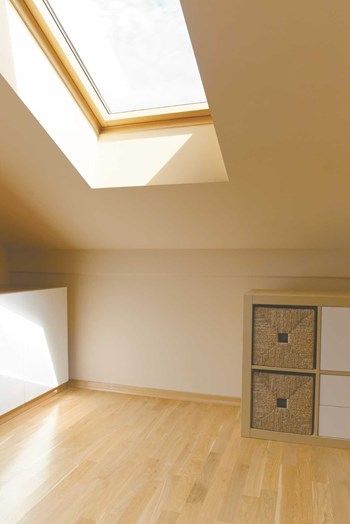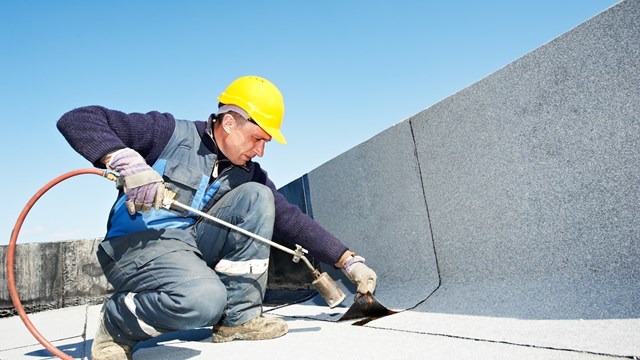
“Light” and “Air” are probably two of the terms most overused by New York City real estate types, but even so, every resident wants more of both in their apartment—and one way to get them is via a skylight. Skylights are often found in the stairwells of multi-story buildings, where their dual-function of providing light and air was essential more than a century ago, before the use of air conditioning. Other types of skylights are intended to bring light and breezes into stuffy top-floor apartments. Still others function purely as aesthetic add-ons to increase the beauty (and in turn, the resale value) of a unit.
The idea of a lofty, spacious living area bathed in sunlight from overhead, its owners protected from (yet still able to enjoy) the pattering rain is a compelling argument in favor of installing a skylight, or purchasing a skylit unit. There can be drawbacks to these sought-after and much-enjoyed building features however, including leaks, security issues, and mechanical and structural problems. Such issues make residents and boards occasionally wonder if skylights are really worth the potential drama.
Talk to a broker or a real estate agent before you roof over that old skylight though, since such a structural change could actually subtract value from your home, rather than adding to it.
Construction & Maintenance
In many city buildings that are a century or more old, skylights are original architectural features that once were essential to comfortable daily living. Situated in the ceilings above stairwells, skylights were usually meant to open in order to ventilate the building's interior spaces during the hot summer months. They also often still bring light into interior rooms—an important job, especially in closely-spaced brownstones where there are no side windows to let in light.
There are a variety of types of skylights, and not all are meant to open. Old-style skylights are constructed of glass with a wire mesh backing and are supported by a steel frame. Other types include those made of tempered glass, which is glass like the type found in a basketball backboard. Another is laminated glass, which is like the glass fond in a car’s windshield. Some high-tech versions include electric, timed shades that are activated according to the homeowner’s wishes.
While some older skylights no longer function, long-sealed and taken out of operating use, residents still are attracted to the open, airy and bright feeling a skylight can give an apartment. “From a broker’s perspective, they add light and are fun and dramatic,” says Hall F. Willkie, president of Manhattan-based real estate brokerage Brown Harris Stevens. “Skylights are positive things but they do tend to be a maintenance item.”
The two common things that these three types of skylights have in common are that they all are made mostly of safety glass, and that they pass New York City’s building code. The city’s code requires that the glass in the skylight, if broken, will not shatter and fall into pieces. It’s an obvious safety provision meant to protect people, says Richard Apfel, executive vice president of Bronx-based Skyline Windows.
Because skylights are set more or less horizontally on a roof, they are also subject to the weather in ways that typical vertical windows aren’t. Skylights take a direct beating from the sun, which can damage caulking and other weatherproofing applications, causing the window to leak. A crack in a skylight window or a break in the flashing around the skylight can both lead to leaks on rainy or snowy days, says Scott Turnbull, manager for Brooklyn-based Windows We Are.
While most of the issues skylights are prone to can be fixed easily enough, the structures themselves must be maintained in order for them to last and not create more problems down the road, says Wilkie, adding that one maintenance issue can be the upkeep of any alarm system connected to the skylight. Industry experts say a motion-detector should be installed on skylights as part of any alarm system meant to protect the building and its residents. Because the windows are on a roof, some will overlook that potential weak spot. “It definitely is another point of entry,” Wilkie says.
If a problem with leaking from a skylight is suspected or found, industry experts recommend that a qualified contractor be hired to inspect the exterior of the window, inspecting all joints and flashing to try to find the leak. Skylights are really built to be able to handle snow, but very heavy snow should be monitored and if possible, such wet snow should be removed.
Many older skylights become costly because the frame in which they sit simply wears out from the stress of sun, wind, rain and snow bearing down upon it year after year. Symptoms of worn-out windows include constant rusting and needing to be painted, or needing new flashing or caulking with increasing frequency. The frame might be telling a story the owner isn’t hearing. Sometimes that old steel or wooden frame of the skylight is lingering past its useful lifetime, requiring that the entire skylight be replaced. In these cases, replacement of the skylight is a more attractive and energy-efficient solution to the problem than perpetually repairing it.
But the older, steel frame skylights still in use can be maintained. They need to be properly sealed with silicone of a tar-based product—often, whichever is in use on the window. Resealing the skylight should be done only after a professional has inspected the seals between the frame and the glass and determined the job is needed.
Older skylights can be maintained in much the same way that metal fire escapes are cared for, says Michael Cervelli, founder/CEO of Cervelli Management Corporation in North Bergen, New Jersey. Both types of structures are made of steel, and both should have their frames scraped of flaking paint and rust and re-painted at least once a year.
Adding Light
Newer types of skylights can include aluminum frames, and sometimes even use a sort of plastic for the pane, rather than glass—though it should be noted that plastic skylights might not pass code in some communities. For that reason, and others such as the fact that the installation of a skylight is related to a building’s structure and thus inherently a safety-related issue, residents interested in installing a new skylight should do so with the help of a licensed engineer or architect, or other certified building professional.
Having a professional’s help will ensure that the skylight is installed properly the first time, saving headaches down the road. In a building feature vulnerable to leaks, proper installation could spare you the expense and inconvenience of leaks and their capacity for property damage. An expert’s trained eye also can help a homeowner to pick an appropriate style of skylight, which is suited to the unit owner’s needs as well as the dictates of the building’s management and the feeling of the building itself.
For many co-op or condo owners who are interested in adding a skylight in their home or replacing one with a newer version, building approval will be needed first. That means getting the building board’s OK on the project. Such approval will always require that the unit owner have the work done under the direction of a qualified professional. Sometimes, the type of skylight used also could be scrutinized by the board, to ensure that the style of skylight is in keeping with the architectural style of the building.
Replacing or adding windows to any home can be tricky, given the variables in weather conditions from place to place and the disparities in architectural styles of homes. Also, any window, especially a skylight, can affect the feeling of a room by flooding it with light, making it feel too public, or in any of a number of other subtle ways that could be difficult for the average homeowner to predict when simply picking a skylight from a catalog. The wrong style of skylight also might not look right for the unit or could appear odd or out of place on top of the building, having the ultimate effect of actually detracting from the value of the apartment and the building.
Experts say any skylight project should be undertaken with caution, and done with a professional’s direction, because each job is different. Even more than replacing or adding windows to a home can be, skylight installation or replacement is unique to each home. There is no one size fits all approach to such projects, because every building and each skylight is at least a bit different than the rest. Sometimes, skylights are custom-made to fit a building’s purposes.
It’s not enough to have a professional design the drawings for the skylight project, a qualified contractor must be chosen to do the work. Because a skylight is tied into a building’s structure, improper installation of one could wreak havoc on the structural integrity of the building if the skylight leaks and it goes undetected for a while. Though many of the newer skylights come in kit form, seemingly easy for any contractor to install, such kits include state-of-the-art rubber gaskets and flashing that not every contractor will be able to install properly.
The advantage to the newer skylight windows, in addition to being lighter and thus less of a load on the roof, is partly their energy-efficiency. That efficiency is enhanced in some models that have glass which keeps out ultraviolet rays. A skylight installed properly can give New Yorkers many years of enjoyment and the light and air that they so crave.
Jonathan Barnes is a frequent contributor to The Cooperator and other publications.






Leave a Comment